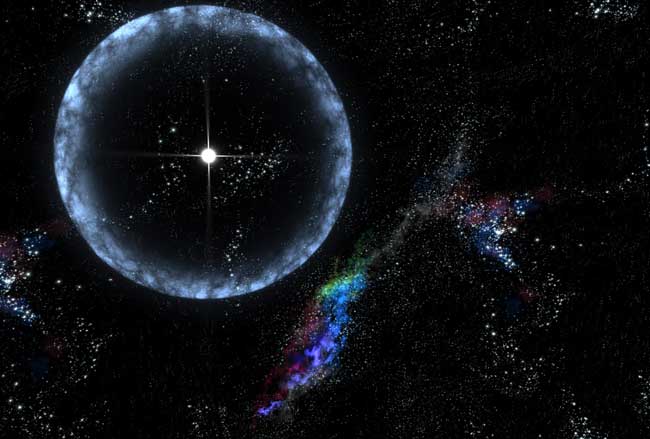The Biggest Starquake Ever

The biggest starquake ever recorded resulted in oscillations in the X-ray emission from the shaking neutron star. Astronomers hope these oscillations will crack the mystery of what neutron stars are made of.
On December 27, 2004, several satellites and telescopes from around the world detected an explosion on the surface of SGR 1806-20, a neutron star 50,000 light years away. The resulting flash of energy -- which lasted only a tenth of a second -- released more energy than the Sun emits in 150,000 years.
Combing through data from NASA's Rossi X-ray Timing Explorer, a team of astronomers has identified oscillations in the X-ray emission of SGR 1806-20. These rapid fluctuations, which began 3 minutes after the starquake and trailed off 10 minutes later, had a frequency of 94.5 Hertz.
"This is near the frequency of the 22nd key of a piano, F sharp," said Tomaso Belloni from Italy's National Institute of Astrophysics.
Just as geologists study the Earth's interior using seismic waves after an earthquake, astrophysicists can use the X-ray oscillations to probe this distant neutron star.
"This explosion was akin to hitting the neutron star with a gigantic hammer, causing it to ring like a bell," said Richard Rothschild from the University of California, San Diego. "Now the question is: what does the frequency of the neutron star's oscillations -- the tone produced by the ringing bell -- mean?"
Neutron stars form when a massive star runs out of nuclear fuel to burn. Under the weight of its own gravity, the star's core collapses into either a dense neutron star, or an even denser black hole.
Breaking space news, the latest updates on rocket launches, skywatching events and more!
The particles inside a neutron star are so tightly packed together that electrons are forced into the atomic nucleus, where they fuse with protons to make neutrons. This pure neutron material is so dense that a spoonful of it would weigh over a billion tons on Earth.
A neutron star with the mass of our Sun would only be 10 miles wide.
Neutron star "geology" is thought to involve a hard outer crust floating over a superfluid core. But the exact details are not known -- like whether the core contains exotic particles called strange quarks. Starquakes may provide the answer.
There are millions of neutron stars in our Milky Way galaxy. Some of these have intense magnetic fields, which are trillions of times greater than the Earth's magnetic field. On the high end of magnetic neutron stars are the magnetars.
The magnetic field of magnetars is so strong that it sometimes warps the crust. This is the probable origin of starquakes. Of the nine firmly identified magnetars, four erupt repeatedly in bursts of X-rays and gamma rays. SGR 1806-20 is one of these so-called soft gamma repeaters.
How SGR 1806-20 rattled after the great starquake of 04 depends on its internal structure.
"This is a rare opportunity for astrophysicists to study the interior of a neutron star, because we finally have some data theoreticians can chew on. Hopefully, they'll be able to tell us what this all means," Rothschild said.
The X-ray oscillations will be reported in the July 20th issue of Astrophysical Journal Letters.

Michael Schirber is a freelance writer based in Lyons, France who began writing for Space.com and Live Science in 2004 . He's covered a wide range of topics for Space.com and Live Science, from the origin of life to the physics of NASCAR driving. He also authored a long series of articles about environmental technology. Michael earned a Ph.D. in astrophysics from Ohio State University while studying quasars and the ultraviolet background. Over the years, Michael has also written for Science, Physics World, and New Scientist, most recently as a corresponding editor for Physics.
